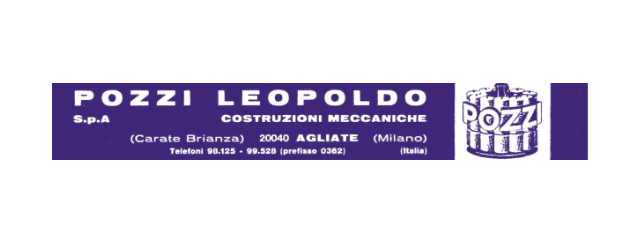
To learn about POZZI LEOPOLDO one must go back to over a century ago.
It was 1885 when the two founding brothers, Gaetano and Raineri, started a small smithery in the heart of Brianza, just north of Milan and not too far from the Como area, where the textile industry was a widespread reality. Soon, in fact, the smithery started to specialize in textile machinery, although during the war years it even came to manufacture bombs and ship chains.
POZZI’s first textile patent dates back to 1925 and in 1940 the Enciclopedia Italiana Treccani published the picture of a POZZI autoclave under the entry “dye-house”.
Since then innovation, creativity and craftsmanship have been pursued with pride and dedication.


1885 marks the founding of the smithery of F.lli POZZI which will eventually turn into the well-established textile manufacturer POZZI LEOPOLDO.

The majority of yarn production is in hanks and POZZI manufactures steel-reinforced wooden vats and bleaching plants. Pumps and piping are made of cast-iron.

The first bleaching plants with under-vacuum technology are manufactured using in-house cast piston pumps. Kiers are made of riveted iron or with multilayered cast-iron rings. Introduction of the centrifugal pump with inversion valve.

The first steel alloys, such as the so-called “nichelina”, start replacing iron and cast-iron elements. POZZI patents the first cone dyeing machine with square invertible carrier and hydro-extractors with oscillating suspension (on gimbals) make their way in the textile world. Introduction of a full line of auxiliary equipment such as hank-openers, presses and so on.

Strategically, POZZI builds a dye-house to demonstrate the technical superiority of the newly manufactured stainless-steel pressure machines as opposed to the cast-iron ones. At this time, there is a huge increase of beam dyeing of cotton yarns and fabric, belt-driven transmission are finally over and POZZI manufactures also dyeing and washing machines for fabric.

Introduction of semi-rapid dryers with rotating compressor; autoclaves are now made of just stainless steel. Fabric is almost exclusively processed in jigger machines. The steam yarn conditioning machine works under vacuum to guarantee uniformity.

Automation is introduced in dyeing machinery and with the increasing processing of polyester temperatures rise: under vacuum reels start to show up and horizontal beam dyeing is far more popular. Pressurized rapid dryers for yarn become standard and hanks move from pool to cabinet machines.

The ruling spirit of essential minimalism eliminates all frills and POZZI introduces jet for rope dyeing, eventually turning into a smoother FLOW machine for a wider range of potential customers. It’s the time of loose dyeing and in Prato, Italy, POZZI creates the first high-density, low-liquor ratio loose-stock dye-house. Hydro-extractors work now with variable speed and dyeing machines are bigger.

The deep oil crisis that started in the ‘70s is another opportunity for POZZI to come up with a revolutionary invention: RCR, the rotating heat recovery system for dirty effluents, proving to be the first real sustainable technology for textile industry and beyond. Thousands of such units are sold all over the world in just a few years. POZZI LEOPOLDO is flanked by POZZI ELETTRONICA to better respond to the increasing demand for new technologies in fully automated dye-houses. New dyeing techniques are under test.

Deeply rooted in an over a century-old experience, POZZI is still the dedicated and competent partner with a vision of progress that integrates immediate and long-term objectives towards high-quality, reliable and sustainable choices for better machines in a better world.
© Copyright Pozzi Leopoldo Srl. All rights reserved. P.IVA 06525320963 - Privacy policy - Cookie policy